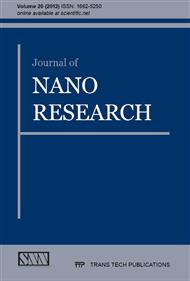[1]
B.E. Conway, Electrochemical Supercapacitors: Scientific Fundamentals and Technological Applications, 2nd edn, Kluwer Academic/Plenum Publishers, New York, (1999).
Google Scholar
[2]
A. Burke, Ultracapacitors: why, how, and where is the technology, J. Power Sources 91 (2000) 37-50.
DOI: 10.1016/s0378-7753(00)00485-7
Google Scholar
[3]
J.R. Miller, Electrochemical capacitor thermal management issues at high-rate cycling, Electrochim. Acta 52 (2006) 1703-1708.
DOI: 10.1016/j.electacta.2006.02.056
Google Scholar
[4]
R. Kötz, Principles and applications of electrochemical capacitors, M. Carlen, Electrochim. Acta 45 (2000) 2483-2498.
DOI: 10.1016/s0013-4686(00)00354-6
Google Scholar
[5]
P. Simon, Y. Gogotsi, Materials for electrochemical capacitors, Nature Mater. 7 (2008) 845-854.
Google Scholar
[6]
P.J. Hall, M. Mirzaeian, S.I. Fletcher, F.B. Sillars, A.J.R. Rennie, G.O. Shitta-Bey, G. Wilson, A. Cruden, R. Carter, Energy storage in electrochemical capacitors: designing functional materials to improve performance, Energy Environ. Sci. 3 (2010).
DOI: 10.1039/c0ee00004c
Google Scholar
[7]
J.K. Chang, S.H. Hsu, W.T. Tsai, I.W. Sun, A novel electrochemical process to prepare a high-porosity manganese oxide electrode with promising pseudocapacitive performance, J. Power Sources 177 (2008) 676-680.
DOI: 10.1016/j.jpowsour.2007.11.039
Google Scholar
[8]
Y.B. He, G.R. Li, A.L. Wang, C.Y. Su, Y.X. Tong, Single-crystal ZnO nanorod/amorphous and nanoporous metal oxide shell composites: Controllable electrochemical synthesis and enhanced supercapacitor performances, Energy Environ. Sci. 4 (2011).
DOI: 10.1039/c0ee00669f
Google Scholar
[9]
E.H. Liu, W. Li, J. Li, X.Y. Meng, R. Ding, S.T. Tan, Preparation and characterization of nanostructured NiO/MnO2 composite electrode for electrochemical supercapacitors, Mater. Res. Bulletin 44 (2009) 1122-1126.
DOI: 10.1016/j.materresbull.2008.10.003
Google Scholar
[10]
B. Choi, S. Lee, C. Fushimi, A. Tsutsumi, Development of NiMH-based fuel cell/battery (FCB) system: Characterization of Ni(OH)2/MnO2 positive electrode for FCB, J. Power Sources 194 (2009) 1150-1155.
DOI: 10.1016/j.jpowsour.2009.06.039
Google Scholar
[11]
Y.H. Wang, H. Liu, X.L. Sun, I. Zhitomirskya, Manganese dioxide-carbon nanotube nanocomposites for electrodes of electrochemical supercapacitors, Scripta Materialia 61 (2009) 1079-1082.
DOI: 10.1016/j.scriptamat.2009.08.040
Google Scholar
[12]
M.W. Dijksma, P.H.L. Notten, Electrochemical quartz microbalance characterization of Ni(OH)2-based thin film electrodes, Electrochim. Acta 51 (2006) 3609-3621.
DOI: 10.1016/j.electacta.2005.10.022
Google Scholar
[13]
W.F. Wei, X.W. Cui, X.H. Mao, W.X. Chen, D.G. Ivey, Morphology evolution in anodically electrodeposited manganese oxide nanostructures for electrochemical supercapaciitor applications – Effect of supersturation ratio, Electrochim. Acta 56 (2011).
DOI: 10.1016/j.electacta.2010.10.044
Google Scholar
[14]
S.W. Lee, J.Y. Kim, S. Chen, P.T. Hammond, Y.S. Horn, Carbon nanotube/manganese oxide ultrathin film electrodes for electrochemical capacitors, ACS Nano 4 (2010) 3889-3896.
DOI: 10.1021/nn100681d
Google Scholar
[15]
M. Toupin, T. Brousse, D. Belanger, Charge storage mechanism of MnO2 electrode used in aqueous electrochemical capacitor, Chem. Mater. 16 (2004) 3184-3190.
DOI: 10.1021/cm049649j
Google Scholar
[16]
C.H. Wu, J.S. Ma, C.H. Lu, Effect of reducing agents on the electrochemical properties of the prepared manganese oxide powders, Current Appl. Phys. 12 (2012) 1058-1063.
DOI: 10.1016/j.cap.2012.01.007
Google Scholar
[17]
D.D. Zhao, Z. Yang, L.L. Zhang, Y.F. Zhang, Electrodeposited manganese oxide on nickel foam-supported carbon nanotubes for electrode of supercapacitors, Electrochem. Solid-State Lett. 14 (2011) A 93-96.
DOI: 10.1149/1.3562927
Google Scholar
[18]
P.V. Kamath, M. Dixit, L. Indira, A.K. Shukla, V.G. Kumar, N. Munichandraiah, Stabilized α-Ni(OH)2 as electrode material for alkaline secondary cells, J. Electrochem. Soc. 141 (1994) 2956-2959.
DOI: 10.1149/1.2059264
Google Scholar
[19]
C. Lin, J.A. Ritter, B.N. Popov, Characterization of sol-gel-derived cobalt oxide xerogels as electrochemical capacitors, J. Electrochem. Soc. 145 (1998) 4097-4103.
DOI: 10.1149/1.1838920
Google Scholar


